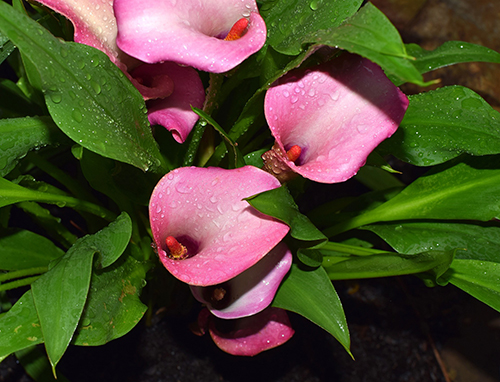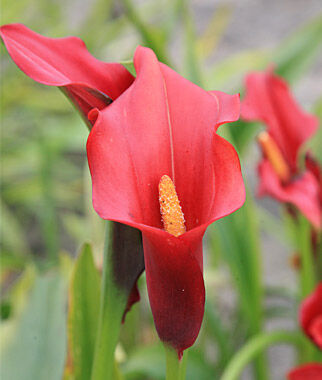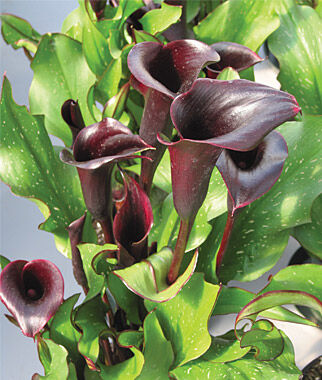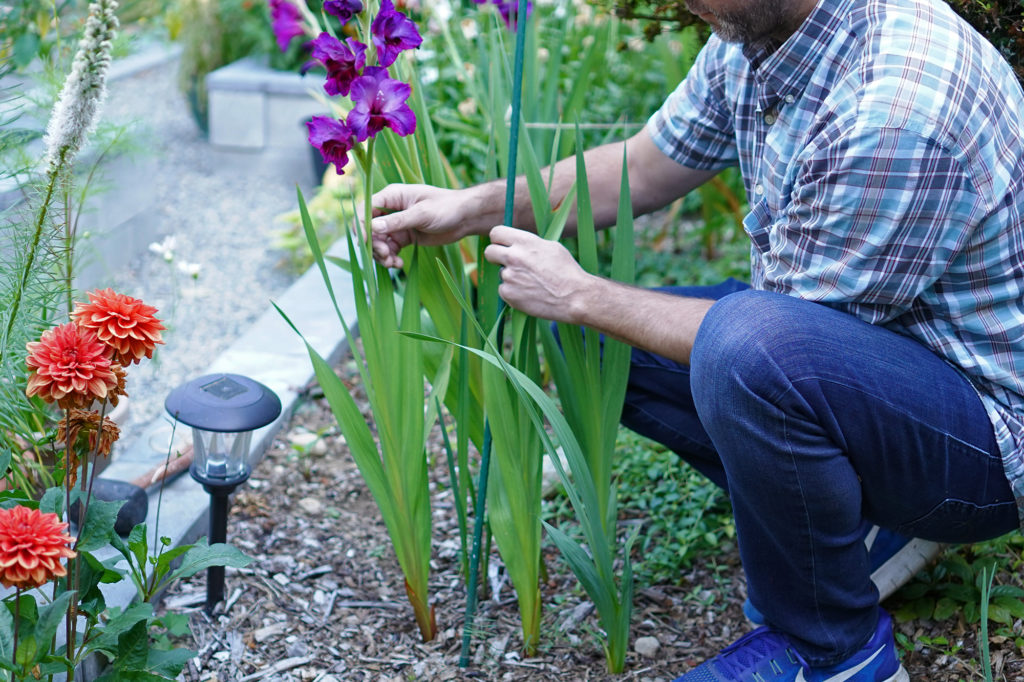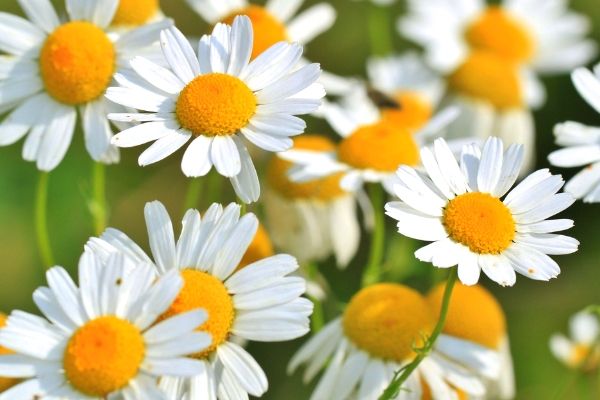There are not too many plants out there with such an interesting history full of name changes, origin stories, and versatility as the Calla Lily.
What plant can you think of that can be used at both weddings AND funerals? With various colors and striking design, this plant had to be our pick for April’s plant profile of the month.
The Calla Lily, often symbolic of purity, holiness, and good luck are actually not true callas or even true lilies. They were incorrectly named and classified. These plants are more closely related to some of our common houseplants such as Monstera and Philodendrons. Another close relative is the Skunk Cabbage, but thankfully it does not share its unfortunate aroma. One thing is for sure, this beautiful, mysterious plant continues to win the hearts of generations of enthusiasts around the world.
If you are looking for Summer Flowering Bulbs to add to your garden, look no further than our ebook
21 Spring-Planted Bulbs For Fantastic Summer Color!
It’s has 60+ pages of summer flowering bulb inspiration and you can get to know the different plant care needs of these 21 gorgeous spring-
planted, summer-flowering bulbs.
Whether you are already familiar with bulbs or are just learning about them, this guide explains what bulbs are, defines the 5 different types of bulbs, the correct planting orientation for each of the 5, and much more.
You also get to know each of these 21 spring-planted, summer-flowering bulbs intimately for their care needs like where they will grow, when they flower, different flower colors they are available in, and which online-retailers you can buy your very own to then add to your garden.
Grab your copy now and start planning your spring and summer flower garden TODAY!
In a hurry? Pin it for later!
Did you know if you plant Calla Lily bulbs in the ground this spring, you can expect them to bloom in about 60-90 days! That means you can cut your own flowers to display in your house by July or bring as a gift to a summer party! The amount of time they need depends on which variety you plant, the temperature of the soil, and weather conditions in your area.
So, what exactly is a Calla Lily? Where did they originate? How should you plant them and care for them in your garden? Read on to learn more about the history, common characteristics and even a few fun facts about this beautiful plant.
Often associated with the Greek word for “beautiful,” the actual evolution of this plant’s popularity is not quite understood. Stories abound throughout Greek mythology involving Zeus, Hercules, and Zeus’ wife, Hera. Hera was tricked by Zeus to breastfeed Hercules (who was not her son) and once she discovered the truth, breast milk spilled from her which dropped to Earth forming beautiful calla lilies.
Eventually, this plant was discovered and categorized by the Swedish botanist Carolus Linnaeus as a Calla Lily. But, an error was made classifying the plant. It turned out that this plant was not even a lily or a calla! Big oops. Unfortunately, by the time this naming error was corrected by German botanist Karl Koch, it was too late. After renaming the Calla Lilies as the genus Zantedeschia, the common name for the flower lived on. Very curious indeed.
The true birthplace of the Calla Lily can be traced to South Africa and possibly other countries located on the southern African continent. In this warm, tropical climate Calla Lilies were born. Eventually, they somehow spread throughout the western world. No one is quite clear as to when they showed up or why. In Europe, some of the first signs of Calla Lilies were depicted in various works of art dating back to the 1600s!
Eventually spreading to the United States at some point, they became a staple at both weddings and funerals. Calla Lilies are often featured in weddings and used in bridal bouquets due to their symbolic significance to life and fertility. It is also the flower associated with a 6th wedding anniversary thus symbolizing the beauty of a couple’s love. On the other hand, Calla Lilies gained popularity as a common funeral flower used to signify a transition to the afterlife.
- Best Flowering Roses For Your Spring Garden
- The Divine Daffodil: March Plant Profile
- All About Clover: Plant Profile
Ok, now that you’ve caught up on a brief history, let’s move on to the common characteristics of the Calla Lily.
The Curious Calla Lily:
| Common/Trade Name | Calla Lily, Common Calla |
| Botanical/Scientific Name | Zantedeschia aethiopica; other species |
| Types | Species aethiopica is usually creamy white; can come with green toward tips of flowers; dwarf cultivars 'Childsiana' or 'Minor'; or larger 'Hercules' cultivar. |
| Zones | Sunset= Zones 5, 6, 8, 9, 12-24, H1 and H2. USDA= Hardy to zone 8a. |
| General Information | Common calla has different cultural needs than the other calla species; Evergreen to Semievergreen so can't dig up and store over winter in colder climates like other calla species need to be; more tolerant of boggy or moist soils, in hotter summer climates they need to be grown in exclusively light shade, but in milder climates they can be planted in full sun with some light shade; plant in the fall to early spring. |
| Native Environment | Native to South Africa. |
| Water Needs | Regular water year round. |
| Mature Height/Width | Grows 2 - 4 feet high. |
| Bloom Time | Late Spring to mid Summer. |
| Flower Colors | Common Callas have creamy white flowers, with some cultivars having green tipped flowers, being taller or shorter, with some having a backward curving and/or flat flower (spathe). Other species have flowers ranging from green, yellow, gold, orange, pink, lavender, purple, red, and different combinations of these colors with various flower-throat colors. |
| Number of Species | 8 species are currently recognized. |
| Sun Exposure | Light Shade in hotter climates. Full Sun with some light shade in milder climates. |
| Fertilize? | Every 6 months. (compost or pelleted time-release work fine) |
| Plant Spacing | Common Callas should be spaced 1-foot apart and 4-inches deep. Other species should be 8 to 12-inches apart and only 2-inches deep. |
| Suggested Companion Plant/s | Groups well with Lavender, Catmint, Freesia, and Creeping Jenny. Also goes well with other late Spring to mid Summer flowering plants. Works well in garden bed groupings or in containers and good as either focal points or accessory plants in a garden. Can also be a part of water gardens on edge in boggy soil. |
| Maintenance Level | - Yearly cleanup of old or any dead leaves or flowers. - Maybe divide if they get too large for the spot. - Common Calla Lily is evergreen to semi-evergreen and isn't dug up or stored over winter, where other species do die back every year and need to be dug up and stored. |
| Pest Susceptibility | None to be really concerned with. |
| Poisonous to Pets? | Toxic to both dogs and cats (by ASPCA), so keep away or out of reach so they can't consume any part of the plant. - Can cause irritation or severe burning in the mouth, tongue, or lips. |
| Edible for Humans? | Toxic to humans, so don't consume any part of the plant for any reason. Keep away or out of reach of children. Can cause irritation or severe burning in the mouth, tongue, or lips. |
| Fun (or historical) Facts | - Calla is Greek for Beauty. - Popular for use in bridal bouquets and for 6-year wedding anniversary. - Calla Lilies are not true lilies. - Rhizome, a type of bulb, but not a true-bulb. - Have little to no fragrance. |
- How to Build Your Very First Raised Garden Bed!
- Top 5 Spring Garden Tasks You Should Start Right Now!
In Closing
If you haven’t planted your Calla Lily bulbs yet, but want to get them to bloom before summer, it is not too late! Grab some now using this link, especially if you want a deep, purplish-black variety called “Black Star.”
Well, that’s all for now. Thanks for reading and we hope we inspired you or educated you in some way with our review about the Curious Calla Lily. For information about updating your yard for the spring and summer season, check out our podcast page. Here are a few posts you might like to read:
- Spring Mulch Reminders – DIY Garden Minute Episode 138 – Podcast
- 7 best reasons mulching your garden is beneficial.
Make sure to watch for our next post where we will discuss the top 9 vegetables you can plant now for a summer harvest. Let us know if you have any questions or comments anytime, we would love to help.
If you liked our article, subscribe below! Follow us on Pinterest, Twitter, Facebook, and Instagram so you don’t miss a thing! See you in the garden!
~ Sean and Allison

